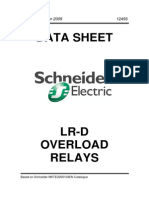RLC Cheat Sheet
RLC Cheat Sheet
Uploaded by
Kirz SerranoCopyright:
Available Formats
RLC Cheat Sheet
RLC Cheat Sheet
Uploaded by
Kirz SerranoOriginal Description:
Copyright
Available Formats
Share this document
Did you find this document useful?
Is this content inappropriate?
Copyright:
Available Formats
RLC Cheat Sheet
RLC Cheat Sheet
Uploaded by
Kirz SerranoCopyright:
Available Formats
1
RLC circuits
= RC, or = L/R, or = 1/ LC, is the time it takes to decay to 1/e times
thep
original. This is only valid for undamped circuits; damped circuits oscillate
at 1/LC (R/2L)2 .
00
0
2
The general
p form of the equation is i + 2i + 0 i = 0; the solutions then are
s1 t
s2 t
2
2
s = 0 ; with i = Ae + Be . The Q-factor, Q = 0 /2, is such
that
At low frequencies or long timescales, an inductor is like a short and a capacitor
is open. At high frequencies and short timescales, the other way around.
When computing timescales, voltage sources act like shorts.
Bandwidth is twice the distance between the resonant frequency and when its
half at resonance; bandwidth is equal to 2; also, /0 = 1/Q. In an RC
circuit, voltage lags current. In an RL circuit, voltage leads current. In an RLC
circuit, something. This can be seen by noting that V = IZ, and so I/V = 1/Z.
So if ImZ is positive (inductive), current lags. If ImZ is negative (capacitive),
current leads.
Solving circuits
DONT PANIC
Set up equations and solve them.
Remember the properties of voltage dividers.
Remember that elements in series can be combined.
Assume that if you get a really messy equation, youre doing something wrong.
Thevenin equivalent: VT H is the voltage you get with no input. To find RT H ,
short voltage sources and open current sources, apply a test voltage VT and
compute RT H = VT /IT .
Remember that current sources constrain the current to be equal to them, and
so do voltage sources. But the voltage across a current source and the current
across a voltage source can be arbitrary.
Remember that all state variables are finite.
Try to make shit look like voltage dividers or whatever. Remember that open
ports dont matter!
MESSY EQUATIONS MEAN YOURE DOING SOMETHING WRONG.
Remember that parallel branches are independent.
When dealing with non-linear elements, find the Thevenin equivalent of the rest
of the circuit, or solve around it.
To calculate power, remember that P = IV = V 2 /R = I 2 R.
2.1
Dividers
A voltage going across resistors in series divides in proportion to the amount of
resistance it has yet to pass through. A current going through Rx divides into
Ix = IRT /(RX + RT ) where RT is the resistance of everything else.
MOSFETs
The fundamental law of a MOSFET is that IDS = K/2(VGS VT )2 when
VGS > Vth and VDS > VGS Vth . When VD S < VGS Vth , IDS = K((VGS
2
/2).
VT )VDS VDS
Current into gate is zero.
For a FET-like thing, where iDS = f (vGS , vDS ), the general model is a voltage
source of gain gm = fvGS (vGS , vDS ) in parallel with a resistor of conductance
fvDS (vGS , vDS ), so id = gm vgs + vds /r.
Small-circuit analysis
Voltage sources become shorts.
Circuit sources become open.
Resistors stay the same.
A MOSFET becomes a current source ids = K(VGS VT )vgs .
More generally, a large-signal thing iA = f (vA ) becomes ia = f 0 (VA )va .
You might also like
- Solid Mensuration ReviewDocument8 pagesSolid Mensuration ReviewKirz SerranoNo ratings yet
- DSE8610 MKII Operator Manual PDFDocument188 pagesDSE8610 MKII Operator Manual PDFLeonardo Limberger100% (1)
- DC and AC CircuitsDocument15 pagesDC and AC CircuitsFabiha SattaNo ratings yet
- Final Review PDFDocument19 pagesFinal Review PDFurfriend_jjn05No ratings yet
- Physics 4 Lab Manual A Resonant CircuitDocument11 pagesPhysics 4 Lab Manual A Resonant CircuitDulika RukshanNo ratings yet
- Transfer FunctionDocument15 pagesTransfer FunctionVarli ArsolNo ratings yet
- Basic Electricity: University of Manchester Department of Computer ScienceDocument14 pagesBasic Electricity: University of Manchester Department of Computer Scienceabinash_pattanaik41No ratings yet
- Eee Lab Report 8Document9 pagesEee Lab Report 8Sayeed MohammedNo ratings yet
- ALLAH The Most Merciful, The Most Beneficent"Document39 pagesALLAH The Most Merciful, The Most Beneficent"api-19788618No ratings yet
- 6 LCRDocument8 pages6 LCRGentianaNo ratings yet
- Unit - II AC Circuits: 4 LecturesDocument19 pagesUnit - II AC Circuits: 4 LecturesLAKSHYA SINGHNo ratings yet
- Kirchhoffs Rules RL RC NotesDocument4 pagesKirchhoffs Rules RL RC Notesniravgandhi93No ratings yet
- 4 TheveninsDocument20 pages4 Theveninsgeorge manNo ratings yet
- R-L & R-C CircuitsDocument41 pagesR-L & R-C CircuitsAlamgir Kabir ShuvoNo ratings yet
- Lec 16Document10 pagesLec 16Muhammad Nabil EzraNo ratings yet
- Lect4 RLC CirciuitsDocument13 pagesLect4 RLC CirciuitsbhaveshNo ratings yet
- ( (Overdamped Voltage Response) )Document12 pages( (Overdamped Voltage Response) )Hayder AliNo ratings yet
- Electrical Circuits: RI The Proportionality Constant R Is Called The ResistanceDocument2 pagesElectrical Circuits: RI The Proportionality Constant R Is Called The ResistanceFilmar AndradaNo ratings yet
- E&E Unit II CompleteDocument50 pagesE&E Unit II CompleteSachin NaagarNo ratings yet
- Circuit AnalysisDocument15 pagesCircuit Analysisoffnrunin100% (1)
- Basics: TOPIC: (2) There Are Two Scinario We Will Encounter in The Network TheoryDocument9 pagesBasics: TOPIC: (2) There Are Two Scinario We Will Encounter in The Network TheorynaveensilveriNo ratings yet
- JFET Circuits II: University of California at Berkeley Physics 111 Laboratory Basic Semiconductor Circuits (BSC) Lab 5Document11 pagesJFET Circuits II: University of California at Berkeley Physics 111 Laboratory Basic Semiconductor Circuits (BSC) Lab 5Marifel CalidguidNo ratings yet
- Aim - Theory - : Multivibrator Has Automatic Built in Triggering Which Switches It Continuously Between ItsDocument6 pagesAim - Theory - : Multivibrator Has Automatic Built in Triggering Which Switches It Continuously Between ItsShahrukh PinjariNo ratings yet
- Chapter Three System Driver 3.1 MOSFET Control CircuitDocument11 pagesChapter Three System Driver 3.1 MOSFET Control CircuitAlhussain EmbarkNo ratings yet
- Analog Measuring InstrumentsDocument43 pagesAnalog Measuring Instrumentsmuvvala charithaNo ratings yet
- A Capacitor Paradox: Q On Its PlatesDocument7 pagesA Capacitor Paradox: Q On Its PlatesJoseph LeeNo ratings yet
- RLC CircuitsDocument26 pagesRLC CircuitsMK100% (1)
- Lab 7 - LR CircuitsDocument11 pagesLab 7 - LR CircuitsANDREYY GORYACHEVNo ratings yet
- BEE Experiment (3,4,5,6)Document25 pagesBEE Experiment (3,4,5,6)xikigo1934No ratings yet
- E6 SolDocument29 pagesE6 SolEmuNo ratings yet
- RC RL CircuitsDocument6 pagesRC RL CircuitsAlia Al ZahmyNo ratings yet
- LRC ManualDocument5 pagesLRC ManualLuke VNo ratings yet
- Alternating Current RL Circuits: 1 ObjectivesDocument7 pagesAlternating Current RL Circuits: 1 ObjectivesElliott M.100% (1)
- EE-221-Review of DC CircuitsDocument51 pagesEE-221-Review of DC CircuitsSean Ng100% (1)
- Transient Response Circuit AnalysisDocument2 pagesTransient Response Circuit Analysispaarshvi20No ratings yet
- Transient Analysis of Electrical Circuits Using Runge-Kutta Method and Its ApplicationDocument5 pagesTransient Analysis of Electrical Circuits Using Runge-Kutta Method and Its ApplicationSwati kNo ratings yet
- Thevinin and NortonDocument44 pagesThevinin and NortonfareenfarzanawahedNo ratings yet
- ElossysDocument12 pagesElossysErro 404No ratings yet
- Astable MutivibratorDocument9 pagesAstable Mutivibratorhemantha dalugamaNo ratings yet
- Ch4 2ODC TransientDocument36 pagesCh4 2ODC TransientBerentoNo ratings yet
- Inductance: Basis of The Electrical Circuit Element Called An InductorDocument57 pagesInductance: Basis of The Electrical Circuit Element Called An InductorJustine J TibaijukaNo ratings yet
- RLC TransientDocument7 pagesRLC TransientAlamaskhan PathanNo ratings yet
- Network Theory EE K-NotesDocument39 pagesNetwork Theory EE K-Notesgunjan bharadwaj100% (1)
- RLC Series and ParallelDocument8 pagesRLC Series and ParallelFaizanAshrafNo ratings yet
- Capacitors: The Impedance of A CapacitorDocument4 pagesCapacitors: The Impedance of A Capacitornavinchopra1986No ratings yet
- Series RLC Circuit: ObjectivesDocument10 pagesSeries RLC Circuit: ObjectivesAhmed JamalNo ratings yet
- Concept of RLRC and RLC Circuit 32Document9 pagesConcept of RLRC and RLC Circuit 32sayem12No ratings yet
- Fallsem2016-17 6988 RM001 02-Aug-2016 Ece1001 EthDocument21 pagesFallsem2016-17 6988 RM001 02-Aug-2016 Ece1001 EthGaurav AgarNo ratings yet
- LRC Transient ResponseDocument5 pagesLRC Transient ResponseskyghNo ratings yet
- 11&12-AC CircuitsDocument8 pages11&12-AC CircuitsZachary DandridgeNo ratings yet
- EC&ED QB For CIE2Document10 pagesEC&ED QB For CIE2bhardamuNo ratings yet
- RC Timers and Timing CircuitsDocument9 pagesRC Timers and Timing CircuitsManuj GuptaNo ratings yet
- Ecn RLCPDocument11 pagesEcn RLCPharshsuryawanshi2021No ratings yet
- Feynman Lectures Simplified 2C: Electromagnetism: in Relativity & in Dense MatterFrom EverandFeynman Lectures Simplified 2C: Electromagnetism: in Relativity & in Dense MatterNo ratings yet
- Easy(er) Electrical Principles for Extra Class Ham License (2012-2016)From EverandEasy(er) Electrical Principles for Extra Class Ham License (2012-2016)No ratings yet
- Letter of RecoDocument1 pageLetter of RecoKirz SerranoNo ratings yet
- Differential Calculus NotesDocument10 pagesDifferential Calculus NotesKirz SerranoNo ratings yet
- Name: - : Summative Test Grade & Section: Date: Subject: Earth and Life ScienceDocument1 pageName: - : Summative Test Grade & Section: Date: Subject: Earth and Life ScienceKirz SerranoNo ratings yet
- Topic 1:: Republic Act 9292Document5 pagesTopic 1:: Republic Act 9292Kirz SerranoNo ratings yet
- Certificate of Parental/Guardian Consent: Noted byDocument5 pagesCertificate of Parental/Guardian Consent: Noted byKirz SerranoNo ratings yet
- Superheterodyne TransmitterDocument3 pagesSuperheterodyne TransmitterKirz SerranoNo ratings yet
- Object StorageDocument10 pagesObject StorageKirz SerranoNo ratings yet
- TB CommandsDocument6 pagesTB CommandsKirz SerranoNo ratings yet
- Television: True/FalseDocument12 pagesTelevision: True/FalseKirz SerranoNo ratings yet
- 03 09 020 Related RatesDocument2 pages03 09 020 Related RatesKirz SerranoNo ratings yet
- Instrumentation and Control of A DC Motor Through The Ubi Dots PlatformDocument6 pagesInstrumentation and Control of A DC Motor Through The Ubi Dots PlatformKirz SerranoNo ratings yet
- KBP Broadcast CodeDocument3 pagesKBP Broadcast CodeKirz SerranoNo ratings yet
- Understanding RF Experiment 8 PDFDocument4 pagesUnderstanding RF Experiment 8 PDFKirz SerranoNo ratings yet
- GreenCom IThings CPSCom.2013.61Document8 pagesGreenCom IThings CPSCom.2013.61Kirz SerranoNo ratings yet
- Pedestrian Tracking With Shoe-Mounted Inertial Sensors: Eric FoxlinDocument9 pagesPedestrian Tracking With Shoe-Mounted Inertial Sensors: Eric FoxlinKirz SerranoNo ratings yet
- College of Engineering and Architecture Department of Electronics Engineering Bacolor, PampangaDocument8 pagesCollege of Engineering and Architecture Department of Electronics Engineering Bacolor, PampangaKirz SerranoNo ratings yet
- Branson S83-85 - Service ManualDocument104 pagesBranson S83-85 - Service ManualAugusto Vieira0% (1)
- Houtu Main Installation PCB SchematicDocument1 pageHoutu Main Installation PCB SchematicjohnnybyzhangNo ratings yet
- Protection and SwitchgearDocument161 pagesProtection and SwitchgearTalat OrhanNo ratings yet
- CH3 Ec304 PDFDocument156 pagesCH3 Ec304 PDFzahrimNo ratings yet
- RAEM1 IoT Monitoring System Data SheetDocument11 pagesRAEM1 IoT Monitoring System Data SheetClaudio FerrariNo ratings yet
- Sign To Speech Converter Gloves For Deaf and Dumb PeopleDocument4 pagesSign To Speech Converter Gloves For Deaf and Dumb PeopleInternational Journal of Application or Innovation in Engineering & ManagementNo ratings yet
- Overhead FPIDocument2 pagesOverhead FPIbibhas_samantaNo ratings yet
- Electronic Voting Machine: Block DiagramDocument2 pagesElectronic Voting Machine: Block DiagramLitika SachdevaNo ratings yet
- Illegal Cordless Phone (Pakistan)Document4 pagesIllegal Cordless Phone (Pakistan)Syed Sameer NaqviNo ratings yet
- Interpretation and Description F Eeg of EEGDocument43 pagesInterpretation and Description F Eeg of EEGexcalidorNo ratings yet
- FSTF120 RUS Damper CortafuegosDocument2 pagesFSTF120 RUS Damper CortafuegosStalin OmarNo ratings yet
- Macroblock Company Profile 2020 - EN - V1.0Document33 pagesMacroblock Company Profile 2020 - EN - V1.0Ion-Tudor RusuNo ratings yet
- Esc SkywalkerDocument1 pageEsc Skywalkersushen_kNo ratings yet
- Arc Interruption TheoryDocument9 pagesArc Interruption TheoryMurari SivakumarNo ratings yet
- Project Report On EEG MachineDocument26 pagesProject Report On EEG Machineneetubansal60% (5)
- Electric Power Control System: DescriptionDocument1 pageElectric Power Control System: DescriptionRoma KuzmychNo ratings yet
- Static Kramer SystemDocument9 pagesStatic Kramer Systemraj_selvaraj10No ratings yet
- Prusa SL1Document7 pagesPrusa SL1faharaNo ratings yet
- Schneider LR-D Overload RelaysDocument17 pagesSchneider LR-D Overload RelaysVasu Iyer100% (1)
- Can Tech 2006 4 CANopen SafetyDocument19 pagesCan Tech 2006 4 CANopen Safetysuperton1No ratings yet
- Apollo ManualDocument24 pagesApollo ManualettorreitNo ratings yet
- Bmtf183t60 Sensors and Actuators 1Document158 pagesBmtf183t60 Sensors and Actuators 1Ganagadhar CHNo ratings yet
- Buchanan 200 Series-19-20Document2 pagesBuchanan 200 Series-19-20JuanPerezRooneyNo ratings yet
- Home Solar Inverter With MPPT X PDFDocument1 pageHome Solar Inverter With MPPT X PDFHrishikeshNo ratings yet
- Getting Started Guide SOLIDWORKS Electrical PDFDocument35 pagesGetting Started Guide SOLIDWORKS Electrical PDFBuianhtuanNo ratings yet
- Image Compression Using Back Propagation Neural Network: S .S. Panda, M.S.R.S Prasad, MNM Prasad, Ch. SKVR NaiduDocument5 pagesImage Compression Using Back Propagation Neural Network: S .S. Panda, M.S.R.S Prasad, MNM Prasad, Ch. SKVR NaiduIjesat JournalNo ratings yet
- Amplitude Modulation Transmission: Am Modulation Module 1 (Amreodica) Pg. 1 of 13Document13 pagesAmplitude Modulation Transmission: Am Modulation Module 1 (Amreodica) Pg. 1 of 13MENDOZA JUDY ANNNo ratings yet
- Slideserve - Co.uk-Hicom Office 150E v2.2 Service Manual PDFDocument1,234 pagesSlideserve - Co.uk-Hicom Office 150E v2.2 Service Manual PDFChaouki Ben JemaaNo ratings yet









































































































